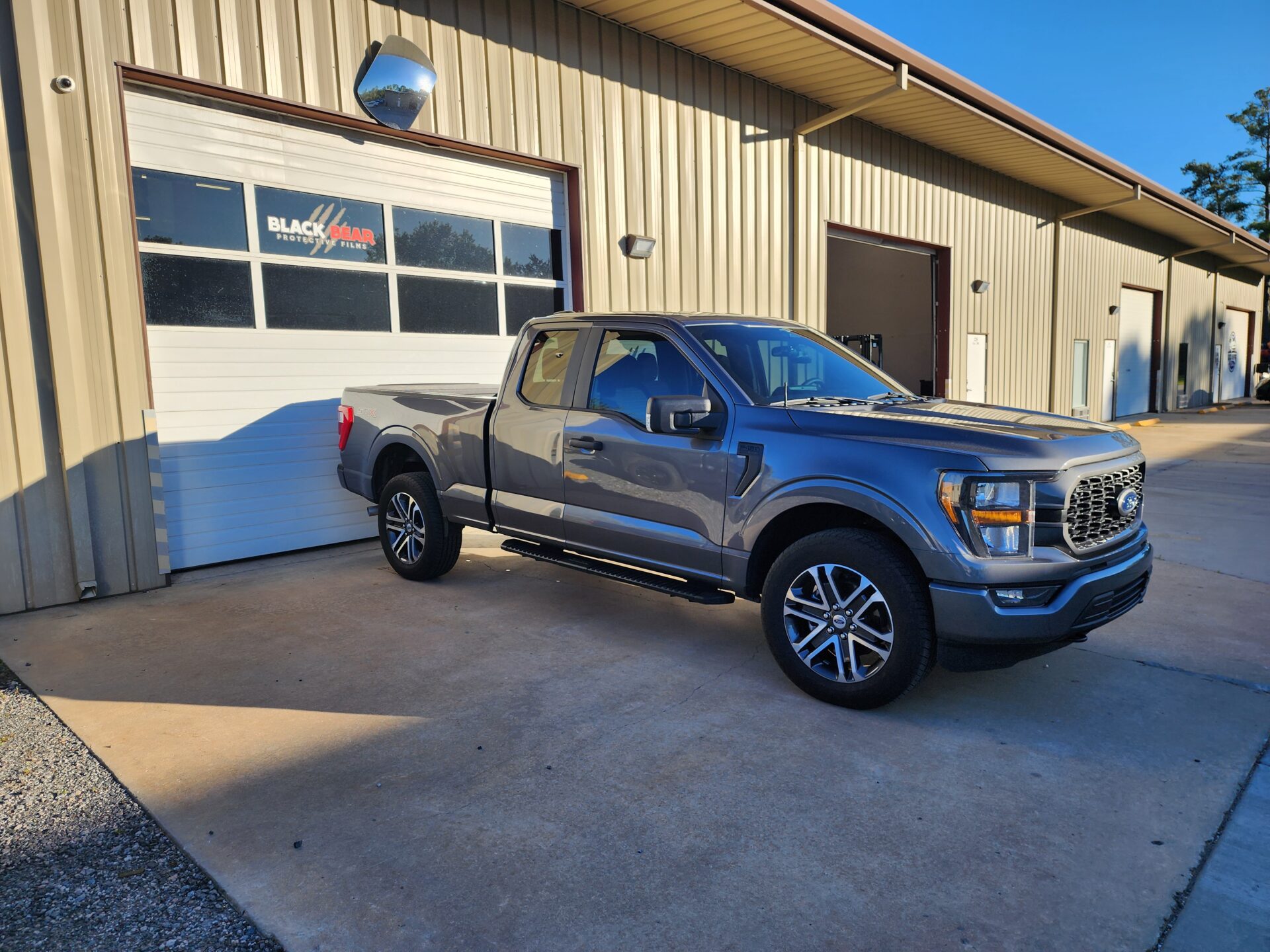Cars today are more advanced than ever, loaded with batteries, touchscreens, sensors, and electronic systems that run everything from climate control to navigation. While these features make driving easier and safer, they also make vehicles more vulnerable to heat. Left exposed to direct sunlight, the cabin quickly turns into a heat trap — and it’s not just uncomfortable for passengers. It puts real stress on the sensitive systems hidden behind the dashboard and under the hood.
Without protection, car batteries and electronics face a daily cycle of heat buildup and strain. This invisible stress shortens their lifespan, reduces efficiency, and leads to performance issues over time. Informational resources from Black Bear Protective Films highlight how something as simple as window tinting can make the difference between stable, long-lasting systems and ones that fail sooner than expected.
Why Sunlight and Heat Are Major Concerns
The Role of UV Radiation in Vehicle Wear
Ultraviolet (UV) rays are silent culprits when it comes to vehicle damage. They pass through untreated glass and attack surfaces and components inside the car. While most people think of UV damage in terms of faded seats or cracked dashboards, the same radiation also affects electronics by degrading plastics, coatings, and sensitive sensors over time.
Prolonged exposure doesn’t just dull appearances; it weakens protective casings around wiring and accelerates the aging of electrical parts. That means electronics become more prone to malfunctions as they lose their built-in resistance to stress.
Heat Build-Up and Its Ripple Effects
When sunlight pours in through untreated glass, infrared radiation ramps up cabin heat. Studies show that interior air temperatures can climb above 120°F (49°C) in less than 30 minutes. For batteries and electronics, these aren’t just uncomfortable numbers — they’re dangerous.
High heat speeds up chemical reactions inside batteries, shortening their effective lifespan. For electronics, extreme temperatures expand and contract tiny soldered joints, eventually leading to cracks and failures. This chain reaction starts with simple cabin heat but ends with costly replacements.
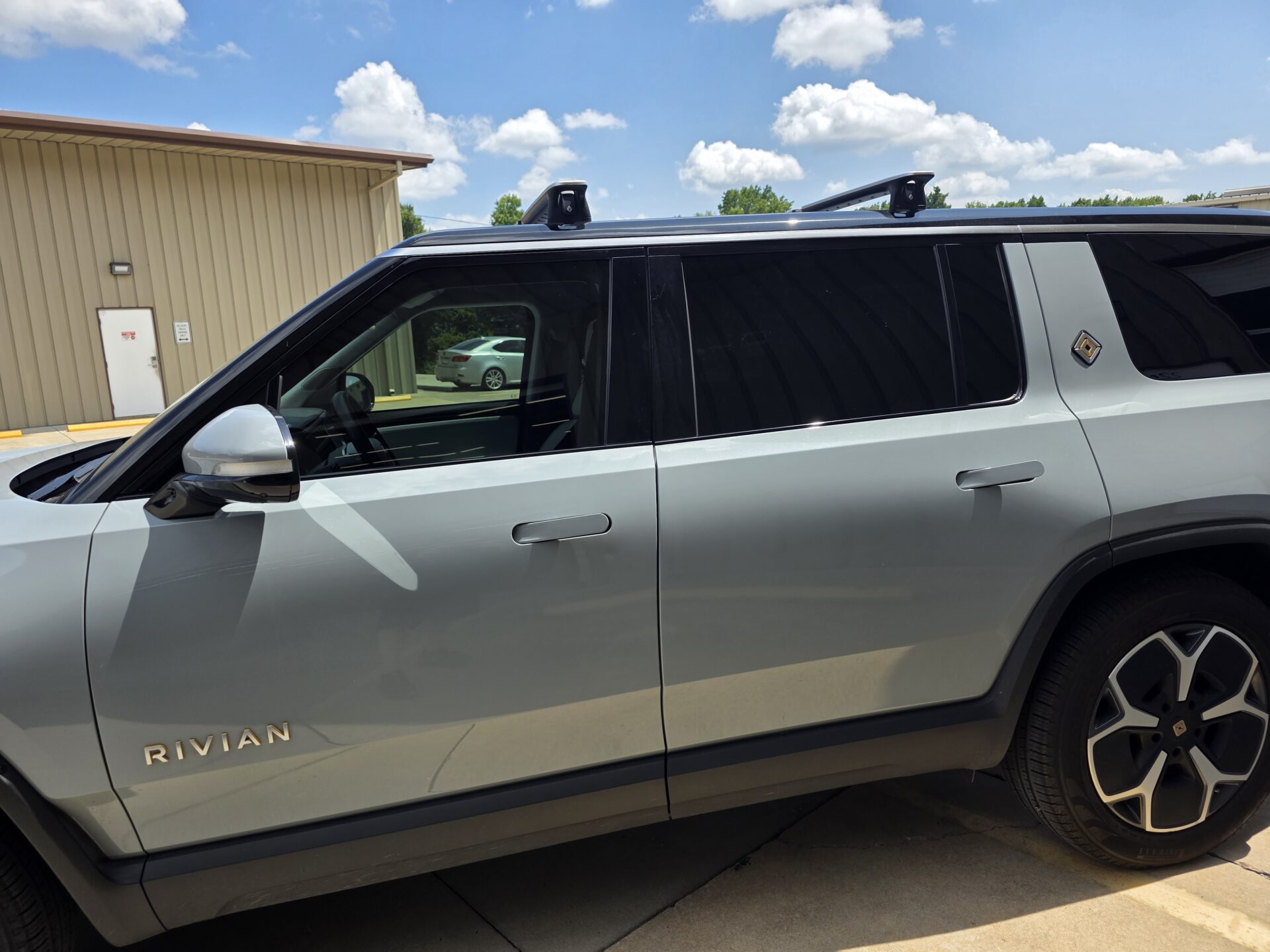
Car Batteries Under Constant Heat Stress
How Extreme Cabin Temperatures Affect Battery Health
Car batteries, especially auxiliary ones supporting electronics, are sensitive to heat. Elevated cabin temperatures strain their cells, forcing them to work harder just to maintain normal performance. This repeated stress cycle accelerates degradation.
Over time, heat-exposed batteries lose their ability to hold charge effectively. Drivers may notice dimming lights, slower startups, or inconsistent power to electronic features — all signs of shortened battery life tied directly to excess cabin heat.
Shortened Battery Life from Overuse of Cooling Systems
The more heat that builds up inside the cabin, the harder the air conditioning system must work. In electric vehicles (EVs), this power comes directly from the main battery pack. In traditional cars, it adds strain to the alternator, which is also linked to battery demand.
This constant cycle of cooling overuse drains available energy and shortens battery efficiency. Essentially, without window tinting, car batteries are forced to overcompensate for conditions that could have been prevented.
Electronics in Modern Vehicles
Dashboards and Digital Displays at Risk
Modern dashboards are filled with LCD touchscreens, infotainment systems, and digital instrument panels. These displays use sensitive liquid crystals and circuits that react poorly to prolonged heat.
Without protection, drivers may face issues like fading screens, unresponsive touch panels, or pixel failures. Once these problems begin, repairs are rarely cheap or easy.
Sensors, Wiring, and Heat Sensitivity
Today’s vehicles rely on countless sensors for safety features like lane assist, parking detection, and climate monitoring. Many of these sensors sit just behind the windshield or dashboard — the hottest part of the car.
Constant heat exposure reduces their accuracy and reliability. Wiring insulation can also become brittle, leading to shorts or electrical malfunctions. Small issues here can snowball into major failures.
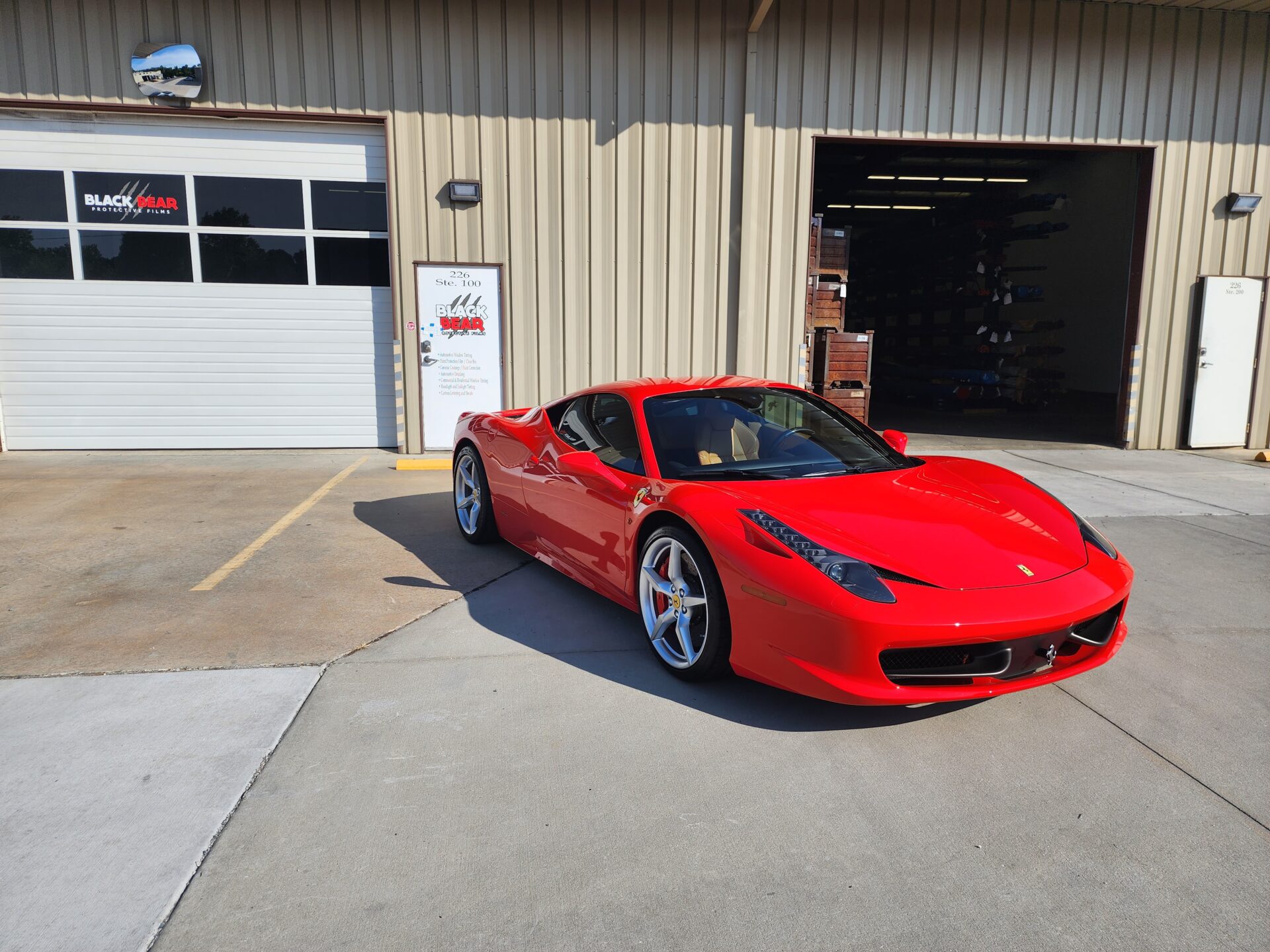
The Chain Reaction: Cabin Heat and Energy Demand
More Cooling Equals More Battery Drain
Hot cabins demand more air conditioning. In an EV, this means fewer miles of range. In gas-powered cars, it means higher fuel consumption and more wear on the alternator. In both cases, energy systems are strained unnecessarily.
Without window tinting, this cycle repeats daily — hot cabin, heavy cooling, higher demand, and reduced efficiency. It’s an ongoing drain that takes its toll on both energy and components.
Long-Term Efficiency Losses
Over years of exposure, the combination of overheated electronics, stressed batteries, and high energy demand adds up. Vehicles lose efficiency, interior systems fail earlier, and maintenance costs increase.
This isn’t an overnight issue but a gradual decline, making prevention even more important.
How Window Tinting Protects Vehicle Systems
Blocking Heat Before It Enters
Window Tinting Indian Land SC acts as the first line of defense, rejecting infrared heat and blocking up to 99% of harmful UV rays. By preventing sunlight from pouring directly into the cabin, tinting dramatically reduces the thermal load on batteries and electronics.
This isn’t about cosmetic benefits. It’s about maintaining a stable environment where sensitive systems don’t have to constantly fight against extreme conditions.
Stabilizing Interior Conditions
A cooler cabin means less energy spent on cooling, fewer cycles of expansion and contraction for electronics, and longer-lasting battery performance. Window tinting doesn’t just make the cabin more comfortable for passengers; it creates a balanced environment that supports the health of the entire vehicle system.
Over time, this stability translates into measurable benefits in efficiency, reliability, and longevity.
Scientific Evidence on Heat Damage
Studies Linking Temperature to Electronics Failures
Research shows that for every 18°F (10°C) rise in operating temperature, the lifespan of electronic components can be cut in half. This highlights just how dangerous untreated cabin heat can be for the delicate systems inside modern cars.
Such data reinforces the importance of preventive steps like window tinting to shield electronics from excessive heat exposure.
Real-World Examples of Heat Impact
Drivers in hot regions often report common problems like failing displays, cracked dashboards, and weak batteries. These issues appear much sooner in cars without tinted glass, proving that the link between cabin heat and component failure is more than just theory.
The contrast between tinted and non-tinted cars over several years is a clear demonstration of tinting’s protective role.
Black Bear Protective Films and Driver Awareness
Sharing Knowledge on Interior Protection
Black Bear Protective Films has highlighted the importance of educating drivers about what happens when cars are left unprotected. By focusing on heat and UV damage, they help drivers understand why prevention matters.
This approach shifts the conversation away from style alone and toward real, measurable benefits like battery health and electronics longevity.
Highlighting Energy and Safety Benefits
Tinting’s ability to reduce cooling demand also ties directly into energy savings and safety. Less strain on systems means fewer risks of sudden malfunctions while driving. By sharing informational resources, Black Bear Protective Films ensures drivers see tinting as protection, not just decoration.
Black Bear Protective Films Serving the Van Wyck and Beyond in Charlotte, South Carolina
Black Bear Protective Films is dedicated to serving the diverse needs of the local community of Charlotte, South Carolina. Including individuals residing in neighborhood like Van Wyck With its convenient location near landmarks such as the “Van Wyck Presbyterian Church, Van Wyck Community Center “major intersections like “US Highway 521 (Charlotte Highway) & Old Church Road and SC Highway 5 & SC Highway 75 (coordinates: 34.81202017881625, -80.8505234) We offer Window tinting services.
Get Window tinting Services at Van Wyck
Navigate from Van Wyck to Black Bear Protective Films
What Happens to Car Batteries and Electronics Without Window Tinting?
- Heat Buildup Inside Untinted Cars:
- Untinted windows allow up to 60% more solar heat inside compared to ceramic-tinted windows.
- Interior temperatures can soar 30-40°F higher on sunny days without tint, causing battery and electronics overheating.
- UV Radiation Damage:
- Untinted glass blocks less than 1% UV rays; interior components and wiring degrade faster.
- UV exposure accelerates fading and electronic component wear, shortening lifespan.
- Battery Efficiency & Range Impact (Electric Vehicles):
- Excess cabin heat increases A/C use, consuming up to 30% more battery power.
- Studies show ceramic window tinting can reduce battery energy consumption by 10-15% by lowering cooling demand.
- Signal Interference Myth Debunked:
- Only metalized tint interfere with electronics; ceramic and carbon tint do NOT affect cell or GPS signals.
- Visual Chart Concepts:
- Bar chart comparing interior temperature (°F) with no tint vs. ceramic tint.
- Pie chart showing % battery energy used for cooling with and without tint.
- Line graph of UV exposure impact on electronic component lifespan over years.
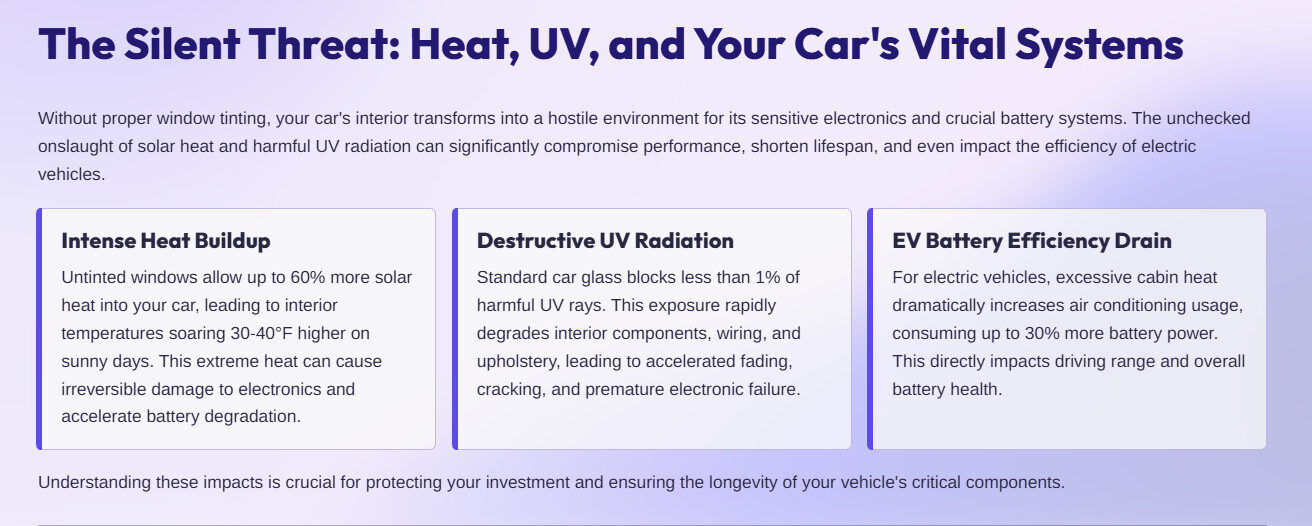
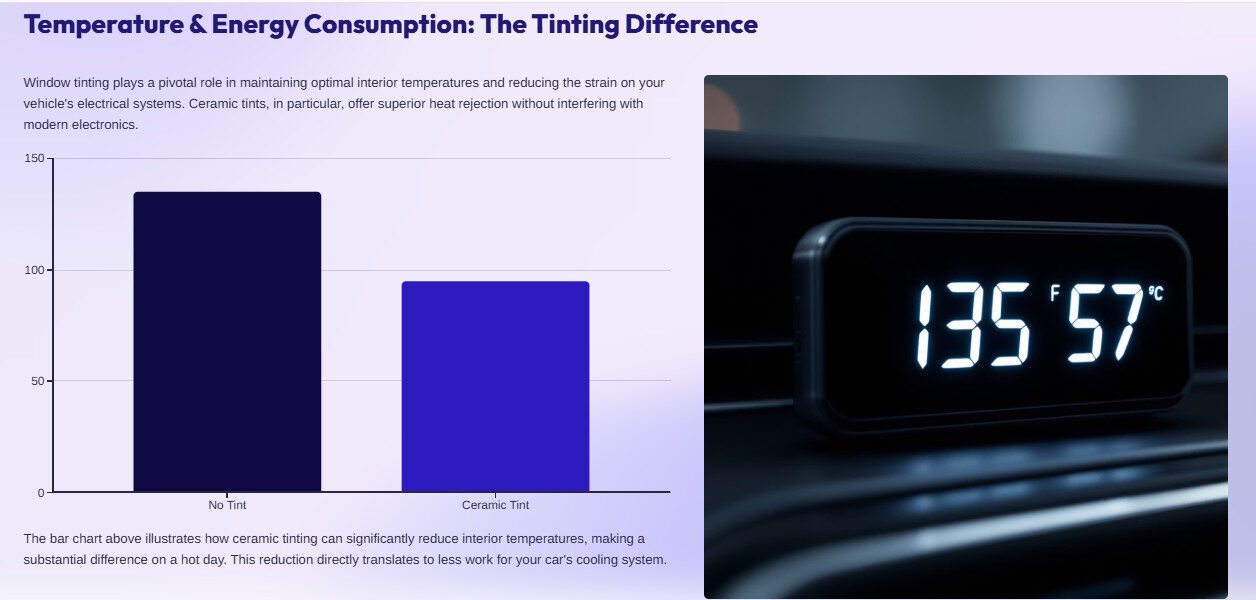

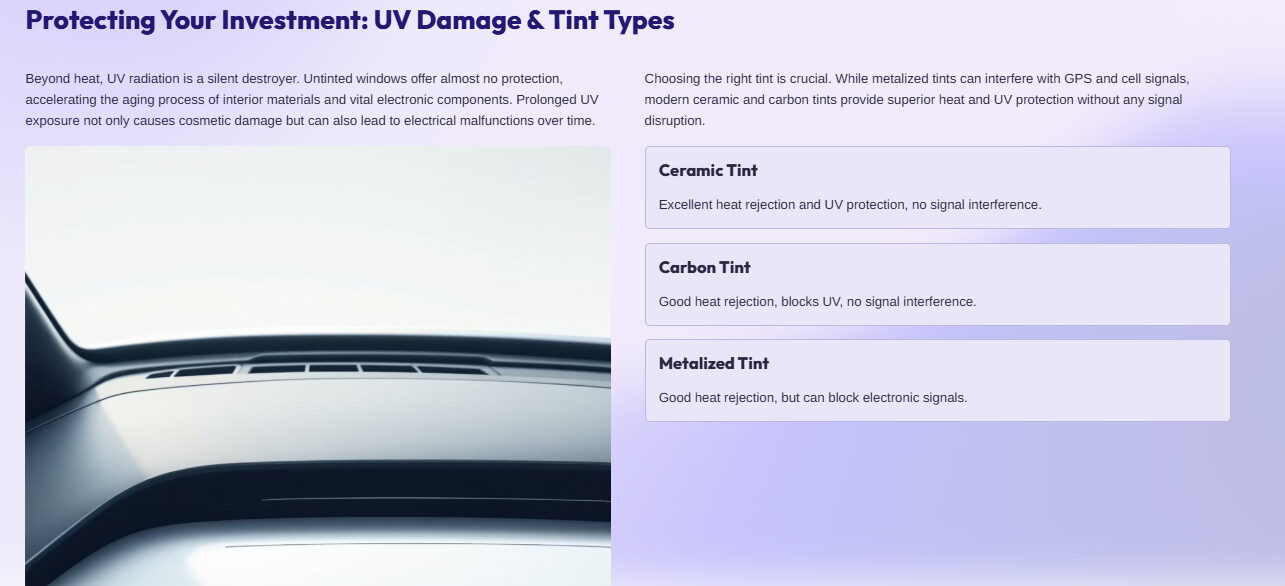
Sources: Automotive Tinting Film Market Report 2025, Ceramic Pro, Raldas Details (2025), Flying Window Tinters (2024)
Car batteries and electronics face invisible but constant stress from sunlight and heat. Without window tinting, these systems operate under harsher conditions, shortening their lifespan and reducing efficiency. Over time, this leads to earlier failures, higher energy demand, and rising maintenance costs.
With clear scientific backing and real-world examples, it’s evident that window tinting is less about appearance and more about protection. Insights from Black Bear Protective Films underline how tinting
safeguards not just the interior, but the essential systems that keep vehicles reliable.
FAQs
Q1: How does heat damage car batteries?
High temperatures speed up chemical reactions in batteries, shortening their ability to hold charge and reducing overall lifespan.
Q2: Why are electronic displays so sensitive to heat?
LCDs and touchscreens contain delicate crystals and circuits that degrade quickly under extreme temperatures.
Q3: Can window tinting really prevent battery drain?
Yes. By reducing cabin heat, less air conditioning is needed, which means batteries and alternators don’t work as hard.
Q4: Does tinting affect all types of vehicles equally?
Both gas and electric cars benefit. EVs save range, while traditional cars reduce alternator strain and fuel use.
Q5: Is sunlight damage gradual or immediate?
It’s mostly gradual. Small cracks, fading, or reduced efficiency accumulate over time, making early prevention essential.
Our Other Blog Posts Related Window Tinting
The Science of Window Tinting: Demystifying VLT for Waxhaw, NC Drivers
How Window Tinting in Indian Land, SC Improves Driving Comfort in Hot Weather
Why Window Tinting in Indian Land, SC Protects Car Interiors from Sun Damage
Energy Savings with Window Tinting in Indian Land, SC for Electric Vehicles
Window Tinting Laws South Carolina | Legal Tint Limits Guide

